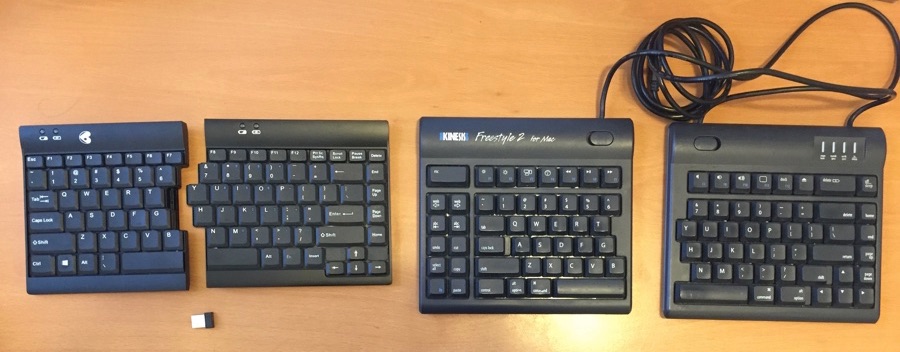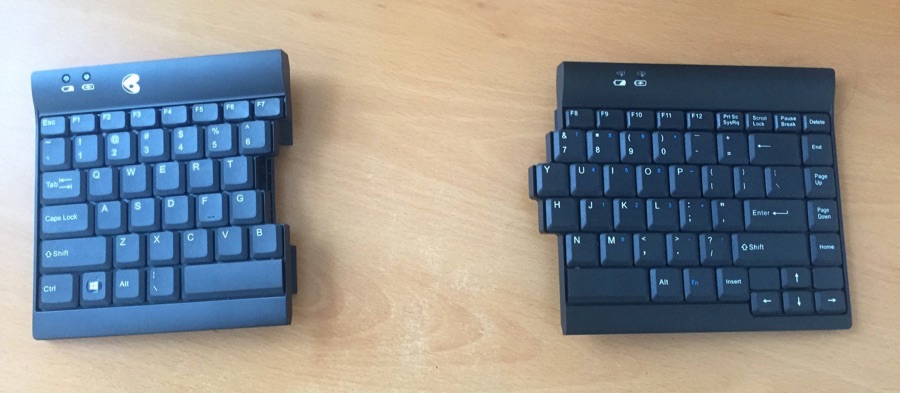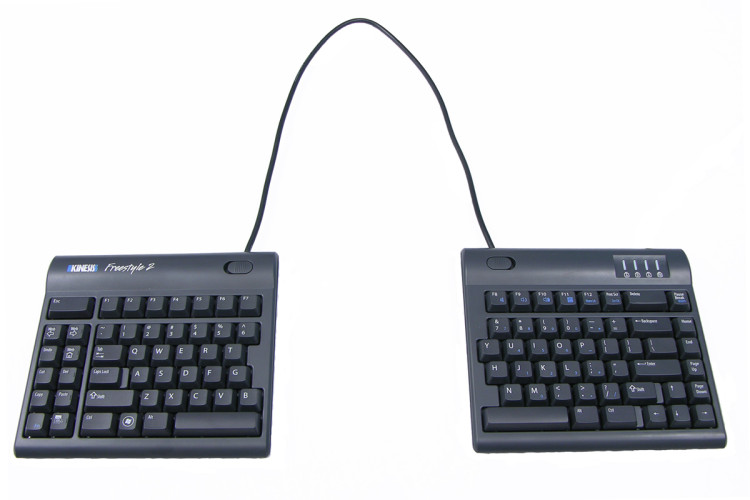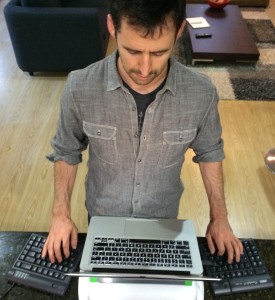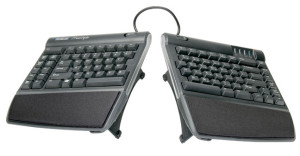Subscribe to blog updates via email »
This split keyboard may be the biggest thing since your standing desk
UPDATE, December 9, 2020: My UltraErgo had a nice life, but since it’s discontinued, I couldn’t replace it. I’m currently enjoying my Mistel BAROCCO MD770, with Cherry MX switches. (I went with the extra-clicky blue.)
UPDATE, September 2, 2017: For the past couple of years, I’ve had readers asking if there’s an alternative to the UltraErgo Wireless Split Keyboard that I now love. Apparently it’s discontinued. The answer is still that I know of no better “truly split” alternative than the Kinesis. Happy to hear other suggestions in the comments.
UPDATE, March 10, 2016: A few months ago, I switched to the UltraErgo Wireless Split Keyboard (thanks to commenters stcorbett and cfc).

WANT TO WRITE A BOOK?
Download your FREE copy of How to Write a Book »
(for a limited time)
Here’s the UltraErgo (left, with its tiny USB dongle), next to the Kinesis (right).
The UltraErgo is objectively better than the Kinesis Freestyle2 on nearly every dimension that matters to me.
- It’s significantly smaller, making it much easier to travel with.
- It has built-in “feet” that flip up and put the keyboard on a tilt.
- It’s wireless (NOT Bluetooth – there is a USB dongle), the primary benefit being that it reduces its size and weight when loading into my backpack.
- I experienced a strange phenomenon with my Kinesis where sometimes keys would register in a different order than I had typed them. I emailed with their engineers, who seemed confident that this wasn’t possible, but still I experienced it both with their wired and Bluetooth versions. I haven’t had this problem with the UltraErgo.
The UltraErgo is not without compromises, though. A few potential “cons:”
- It’s primarily made for Windows, but I use it fine on my Mac. So, there’s a “Windows” key, which I have used Keyboard Preferences to designate as “alt/option.” I have the “Alt” key set to function as the “Command” key.
- Where the left “Command” key would generally be, there is instead a backslash key \ which I still hit accidentally.
- There is no way I know of to change the volume with the Function keys. I can change the brightness with the “Scroll Lock” and “Pause Break” keys, but there is nothing graphically to indicate that on the keyboard.
- The biggest, scariest “con” is that it relies on a tiny USB dongle that has to be in the computer for the keyboard to communicate “wirelessly.” I live in fear that I will someday lose this dongle, and wonder how hard it would be to replace. I simply leave it in my USB port all of the time in the hopes that will prevent my losing it.
Since portability is a huge factor for me, this keyboard is a clear winner for me, but if you’d prefer a keyboard built for a Mac, you may prefer the Kinesis.
Here is the UltraErgo as I use it. There are two “slant” settings, and I prefer it on the lowest one. Notice that there are “battery” indicators on the UltraErgo. The keyboard comes with a mini-USB (?) cable for charging (?) the keyboard. I never had to use this, but I did it anyway, and that was months ago. The keyboard came with no instructions nor manual.
Here is the UltraErgo ready to be put in my backpack (I just keep the tiny dongle in my USB port), next to my Kinesis. You can see the flaps that deploy to slant the UltraErgo. The difference in size and weight is night-and-day in a backpack.
Now, back to the original post:
Standing desks are everywhere these days. More and more office workers are switching over to standing desks, to prevent the health problems associated with sitting.
While it’s great that people are taking healthy computing seriously, it’s surprising that it’s taken this long for standing to really catch on, when it seems obvious: if you have legs that work, what good does it do them to be sitting around all of the time?
A funny-looking keyboard may be the biggest ergonomics craze since the standing desk
I recently discovered a keyboard which is as good of a fit for the human body as the standing desk. It looks pretty strange, but I’m personally convinced this is going to be a very big deal as people get more informed about healthy computing.
Here’s how your standard keyboard is hurting you
Much more often than you hear people complaining about computing-work-related problems with their legs, people tend to have problems with their neck and upper back.
One study of office workers found that 56% of workers have neck problems, and 50% have upper back problems.
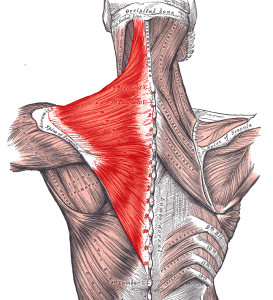
The Trapezius muscles help support your outstretched arms. Good for hugs.
These problems are often a result of tension in the trapezius muscles. These muscles connect to your head, spine, and shoulder blade, and help support your arms.
A big source of this tension is the way we interact with keyboards. When you use a standard keyboard:
- You have to get your hands close together to type on the keyboard.
- To get your hands next to each other, they have to go “around” your body, so your arms have to reach out from your body to reach the keyboard.
- Because your arms are now stretched out, your trapezius muscles tense to support the weight of your arms.
- Your shoulders are now forward, so your pectoral muscles are shortened.

Standard keyboards make you reach your arms out & around your torso.
Having this stress on your upper back also makes it easy to slouch. With this disastrous chain reaction, it’s no wonder that neck and upper back problems are so common amongst people who do lots of computer work.
The muscle tension you don’t even know about is cutting off your circulation by 80%
You may think that this is all pretty trivial – that you don’t feel any tension at all when you’re sitting in front of a standard keyboard. But, the fact of the matter is that people aren’t even aware of the tension that is in their muscles.
Dr. Erik Peper – a healthy computing expert that has been featured on ABCNews.com and in GQ, Glamour, and Men’s Health – and his colleagues recorded the muscle activity of subjects while resting, holding their arm in the air, and then while resting again.
All of the subjects were surprised at just how much activity was going on in their muscles, even though they thought it felt like nothing at all to hold their arm up for a few seconds.
Your muscles tense without you even knowing it
Look at this chart below, which shows the muscle activity of a clinical patient. That big spike marked “1” is her muscle activity when she was simply listening to instructions on what to do.

Muscle tension is high even when just listening to instructions (1).
Just by thinking about moving her muscles, there was already muscle activity going on. When she was actually performing the task, the actual muscle tension (marked “2”) was hardly as intense as when she was just thinking about performing the task.
As you can see where the chart is marked “3,” muscle tension persisted even after the task was performed.
By working on computers, not only are we creating tension in our muscles (that doesn’t quickly subside), we’re too oblivious to what’s going on with our bodies to even know it, because we’re so focused on the task at hand.
I called Dr. Peper (no relation to the soft drink) to learn more about what, exactly, is so bad about about having your muscles tensed 8 hours a day.
Muscles, by their very nature, are made to contract and release. But, when you tense a muscle, you cut off circulation by as much as 80%.
So, even if you think that reaching around your body to get to your keyboard isn’t placing tension on your trapezius muscles, it’s probably more tension than you think, and that tension is cutting off circulation wherever it occurs.
Your brain is attacking your trapezius muscles
Not only is the position of your arms with a traditional keyboard creating tension in your trapezius muscles, the way that you’re processing information as you’re concentrating on your work is creating added tension in your trapezius muscles.
Dr. Peper explains, “when you work, you are constantly vigilant. This state of ‘vigilance’ is heightened by the fact that information hits your amygdala (the ‘fight or flight’ part of your brain) 22ms faster than it hits your cortex (the more rational, reasonable part of your brain).

Your amygdala is not good for hugs. It gives your “traps” a beating.
“You’ve experienced this imbalance in information processing if you’ve ever said something you regretted in an argument. This imbalance is in full effect when we’re on a computer, and hyper-focused on a task.”
This “cortex deficit” probably explains YouTube comments. Mystery solved.
Your trapezius muscles tend to tense when you have the fight/flight/stress response caused by this “cortex deficit.” So, not only are your poor shoulders and trapezius muscles in this unfortunate position all day because of your keyboard, they’re also getting attacked by your hyper-vigilant amygdala.
It’s no wonder that those chair massages are such a hot commodity at the Whole Foods. You know, the ones where the masseuse drives his knee into your upper back to try to undo all of the knots you’ve tied into it?
Split keyboards help reduce the tension in your shoulders
One of the best ways to reduce tension like this is to improve the ergonomics of your workstation, and Dr. Peper recommends a split keyboard for this.
For almost anybody who doesn’t need a number pad right away, get rid of your normal keyboard, and get a split keyboard.
One such keyboard is the Gold Touch, which is what Dr. Peper uses himself; but for some people – such as myself – it’s too narrow.
Try this experiment to see if the “truly split” keyboard is right for you
There are lots of “split” keyboards out there like the Gold Touch, but you may still have to wrap your arms around your torso a bit to get your hands on the keys. If you’re more comfortable having your arms by your sides, then a “truly split” keyboard – one that consists of two independent pieces – may be better for you.
Try this experiment:
- Put the fingers of your left hand on your right shoulder, where your shoulder meets your chest.
- Now, try putting your right hand on your keyboard, as if you were typing.
- Now, move your right hand to the right, outside your keyboard.
- Now that your right arm has cleared your body, you can have your hand closer to your body. Slide your right hand toward yourself a bit.
Did you feel how much your shoulder and chest moved? Did it feel more natural and comfortable to you? If so, you might like a “truly split” keyboard, like the Kinesis Freestyle 2.
The Freestyle actually consists of two pieces, which allows you to keep your hands farther apart. I’m a skinny guy, but since I have totally insanely ripped shoulders from doing the INSANITY® program, having my hands right in front of my body all of the time tightens my chest and trapezius muscles, thus building up tension and restricting my breathing.
I couldn’t lift my own head
I got up close and personal with sneaky neck and upper back problems several months ago. I was feeling fine, when all of the sudden, as I lifted my arms to dry my hair after a shower, a tangle of knots sprang up in my upper back and neck.
I was in so much pain, almost no position was comfortable. Sitting upright was too much stress on my neck, lying down hurt because my head was on my pillow, and I actually had to cradle the back of my head with my hand just to lift it out of bed.
I couldn’t work, and I had to get a couple high-dollar massages just to undo the damage. It took two weeks to recover.
At that point, I decided it’s much better for me to have my arms at my sides when I’m working. This can be true for many types of bodies, whether your arms need to get around a belly, or if you’re a woman who has large…impediments…on her chest.
[UPDATE: 11/01/2016] I eventually discovered that my muscle tension was exacerbated by “Chronic Lyme Disease,” or some similar illness. I do, however, still swear by my split keyboard.
Your laptop is “a disaster.” The “truly split” keyboard is perfect for the mobile worker.
One of the biggest challenges to having an ergonomic workstation is that many of us are mobile now. It’s great that we can set up with our laptop at a coworking station, a cafe, or just on our couch, but that’s the problem.
Unfortunately, as Dr. Peper puts it, “A laptop, by definition, is a disaster.”
Here’s just a few things that make a laptop an ergonomic nightmare:
- You put a laptop on…your lap (or a table).
- Then you have to decide: do you want to crane your neck down at your screen, or have the laptop so high that you feel like a Tyrannosaurus Rex?
- You have to put your hands together to type on the unergonomic keyboard, which forces you to find a way to get your arms around your torso and beyond the trackpad, thus putting stress on your trapezius muscles.
Here’s the setup that I like to use when I visit a coworking station with my laptop:

(Dr. Peper notes that facing a window like this causes glare, and isn’t an ideal setup. Your screen should be perpendicular to any windows.)
- Kinesis Freestyle 2 keyboard (PC version), which allows me to keep my arms at my sides. I went with the model that has the 20″ cord, because then I can put it on either side of my laptop.
- AViiQ Portable Quick Stand, which lifts the screen of my laptop up a few inches, so I don’t have to crane my neck down so much.
- The trackpad on my MacBook Air is still perfectly positioned. I can access it with a much more natural wrist and arm position than I could the keyboard.
It’s still not ergonomically perfect. Even if I could get my screen as high as eye-level, then my trackpad would be too high. The AViiQ helps find a happy medium as far as that is concerned.

The Kinesis Freestyle 2 & AViiQ stand fit in even the smallest backpacks.
Best of all, this entire setup is totally portable. The AViiQ collapses, and since the Freestyle 2 is made of two pieces, it folds up and everything fits even into my tiny Tumi Empire Zepplin backpack (this is discontinued, but it would probably all fit in a Marley as well).
The versatility of the “truly split” keyboard is also great for office setups
For companies who have to do bulk-buying of keyboards that fit a wide variety of needs, the Freestyle 2 is also great because it can be set up any way you like it. You can keep the two sides of the keyboard as close or as far apart as you want, and each hand can be angled as desired.
If you want to take things a step further, you can even get some of the accessories, such as the VIP 3, which adds wrist rests, and angles the keyboards a bit.
Arguably one of the best features for using the Freestyle 2 at your desk is that you can have yourself a snack while you work:
The most useful feature of the #splitkeyboard by far @kadavy pic.twitter.com/dR9ZgVzxgv
— Mccfreedom (@mccfreedom) November 19, 2013
The drawbacks of the Freestyle 2
I did a lot of looking around to make sure the Freestyle 2 was the right “truly split” keyboard, and it turned out, it was really the only viable option. So, there are drawbacks that I have to live with.
- It’s (sort of) expensive. Some of you may have sticker shock at a $115 keyboard, but if you are a technology worker who earns his bread through his keyboard, you think this keyboard would suit you well, and you think that price is a deal breaker – stop being a dumbass. That’s fractions of a penny per billable hour for your comfort and longevity. But, if you don’t need a 20″ separation, you can always save a few bucks with the 8″ separation model.
- It’s not an Apple keyboard. By most objective measures, this keyboard sucks. It looks like it’s from 1995, it’s bulky, and it takes some really solid keystrokes to register. If a soft feel to your fingers is more important than the rest of your body, this keyboard isn’t for you.
- There is a learning curve (and you have to type “right”). Most people ask me how I can manage to type on this keyboard, and there was definitely a learning curve. I swear, I could feel my brain being rewired as I figured it out. Fortunately, I already typed the “right” way, so it just took a couple of days to ramp back up, however, I still hit the wrong key now and then, as the option keys are in slightly different places than my Air keyboard.
There are some compromises to be made with this keyboard, but I am a convert to “truly split” forever. I will be your first Kickstarter backer if you’re a hardware person who can design a slim, lightweight, bluetooth “truly split” keyboard I’m pretty happy with my UltraErgo now.
Will this keyboard fix everything?
As great as this keyboard is, ergonomics are only one piece of the healthy computing puzzle. Even if you get this keyboard, you can’t expect to pound away at it for 12 hours a day for the rest of your life. Dr. Peper cautions that paying attention to personal stress, and the “silent” tension inside of your body can go a long way in keeping yourself productive and healthy.
The most important part is that you need to move as often as possible. Once we begin working we are stuck in place. This leads to chronic low level of unaware muscle tension. People should be taking breaks. That is the cheapest intervention.
Dr. Peper recommends the Stretch Break program to remind you to keep your body moving. I personally have been using AntiRSI for years, but Stretch Break provides more guidance.
More healthy computing resources
- How to Ergonomically Optimize Your Workspace (Lifehacker)
- Healthy Computing: Chest Stretch (article by Dr. Peper on how to stretch out chest muscles shortened from slouching over a keyboard)
- The Peper Perspective (Dr. Peper’s blog)
- Healthy Computing Tips
- Taking Breaks for Healthy Computing
Think your standing desk is great? Check out this weird keyboard: http://t.co/fRYVOrXlzG
— ? David Kadavy | Time ?? Mind Management (@kadavy) February 11, 2014

